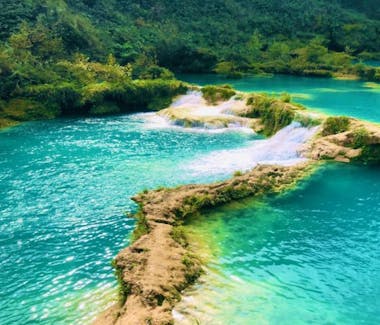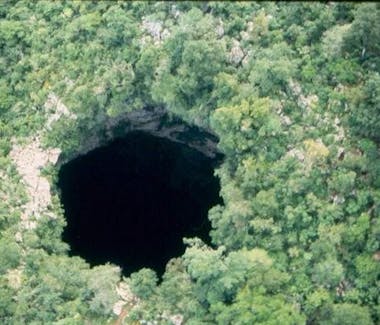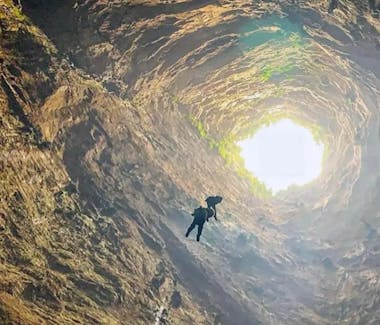Attractions
List of attractions

Aquismón, San Luis Potosi, Mexico
Tamul waterfall (Aquismon municipality)
The Tamul waterfall is a waterfall in Mexico, the largest waterfall in the state of San Luis Potosí, at the top of the Santa María River canyon, 300 m deep.

Puente de Dios, Tamasopo, San Luis Potosi, Mexico
Puente de Dios, Tamasopo, SLP (God´s Bridge)
It is a true natural paradise in which the turquoise water contrasts with the green of nature, this gives us an idea of what we will find in this beautiful place. The passage of time and the force of water managed to sculpt a type of natural cavern with a peculiar bluish and transparent current. Here you can enjoy and swim in a natural pool that is surrounded by gentle falls of water similar to small waterfalls. In addition, you will find stalactites and stalagmites on the walls, which will make your tour a memorable experience.


Cascadas de Micos, Valles Río Verde, Cuauhtemoc, Ciudad Valles, San Luis Potosi, Mexico
Micos (Monkeys Waterfalls)
The Micos waterfalls are a stepped set of water falls, formed by the “El Salto” river and the salts carried by the current create an intense blue in its pools, framed by the greenery of the vegetation, which at one time housed countless of “night monkeys” (Martuchas or kinkajú (Potos flavus), which gave the site its name, but which are now almost extinct.



Carretera El Meco - El Salto, San Luis Potosi, Mexico
Cascada El Salto, Municipality of El Naranjo (The Jump Waterfall)
This waterfall is located within the Sierra del ¨Abra Tanchipa¨ Biosphere Reserve, which is one of the largest in the world. In addition, this large waterfall has petrified rock formations, this is due to the minerals that They formed small natural pools or pools, where you can swim peacefully. Something that also makes them fascinating is the beautiful turquoise green color of their waters, which is a natural phenomenon that is rare in the waterfalls of Mexico. El Salto is located in the Huasteca Potosina, precisely in the northern part of the municipality of El Naranjo, which is located in the town "El Meco", where a waterfall is located that is divided into two parts, the first is part of the El Salto waterfall, where a type of private dam is formed where electricity is generated, the second part is a waterfall called El Meco, which has pools and a 131 ft high waterfall.



CASCADA EL MECO, Carretera El Meco - El Salto, San Luis Potosí, Mexico
Cascada El Meco, (Municipality of EL Naranjo)
Here is another impressive waterfall called Cascada el Meco.
It is a 131ft high waterfall that is basically at the end of the rapids below El Salto waterfall which is another popular spot. You can view the waterfall from a viewing point above or take a boat ride that will take you right in front of and below it. While you can't swim right in front of the waterfall, you can get off the boat further down and jump off a cliff into the turquoise blue river. After the boat ride you can also enjoy a swim in the natural pools. The water here is possibly the bluest water you will ever see in your life!


Cascada de Minas Viejas, San Luis Potosi, Mexico
Cascadas de Minas Viejas (Municipality of El Naranjo)
These are two 164 ft high waterfalls, surrounded by lush vegetation, which form a natural pool.
Here you can camp and swim, as well as visit the surrounding area where other waterfalls and the Patos (Ducks) Lagoon are located, where you can fish. This waterfall, due to the color of its waters and the vegetation that surrounds it, Shows a incomparable beauty.
It is very close to the group of waterfalls in the municipality of Tamasopo, S.L.P.




Jardín Escultórico Edward James, Las Pozas, Xilitla, San Luis Potosi, Mexico
Edward James Sculptural Surealistic Garden, (Municipality of Xilitla).
Edward James Sculptural Garden, Las Pozas, declared an Artistic Monument of the Nation in 2012. The Garden is presented as the most important surrealist space in Mexico where the structures dialogue with the jungle. Located in the Magic Town of Xilitla, in the Huasteca Potosina.
The story goes that Edward James, one of the most interesting eccentrics of the surrealist movement of the 20th century, identified by a fine sensitivity, arrived in Xilitla, San Luis Potosí, Mexico, at the end of the 1940s. The British writer, was captivated by the splendor of the landscape of "Las Pozas", creating a fantastic home that includes a unique sculptural space of its kind worldwide, described by Salvador Dalí as -"The craziest of all the surrealists combined." He designed a sculpture garden that challenges architectural etiquette and invites us to a new look that moves between fantasy and reality: Columns with giant flower capitals, Gothic arches, dramatic doors, pavilions with indeterminate levels and spiral staircases that end abruptly in the air, like an invitation to the horizon. In short, Edward James made a concrete expression along the lush flora and fauna of Xilitla, the design of a possible surrealist architecture.




Sótano de las Golondrinas, San Luis Potosi, Mexico
Sótano de las Golondrinas (Cave of Swallows)
The Cave of Swallows, is the most spectacular natural abyss in Mexico. It is an enormous vertical cavity of karst origin, formed by the erosion of water over millions of years in this limestone soil. You should know that it is a natural refuge for several species of birds, especially swifts (commonly confused with swallows, hence the name of the cavity), as well as parrots, cave parrots and bats. It has a depth of half a kilometer